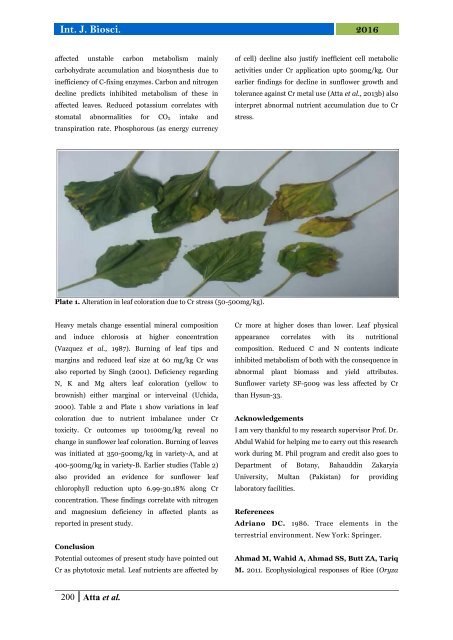Understanding leaf biochemical traits for Sunflower (Helianthus annuus L.) cultivars grown in chromium stressed environment
Abstract Environmental pollution is big curse for plants, animals and other living organisms. Being atmospheric pollutant, different levels of Cr6+ (50-500mg/kg) were applied to sunflower plants to determine its toxic effects. It was found that there was imbalanced distribution of leaf nutrients. XRF studies for various elements revealed alteration in leaf appearance due to nutritional deficiency. Leaf protein was reduced and proline increased pretentiously (p≤0.05) along Cr concentration. Viability of Cr enriched plants strongly showed the environmental protective role of proline. Present study mainly expresses chromium metal toxicity for carbon and nitrogen metabolism predicting poor growth, biomass and yield attributes in Cr treated plants.
Abstract
Environmental pollution is big curse for plants, animals and other living organisms. Being atmospheric pollutant, different levels of Cr6+ (50-500mg/kg) were applied to sunflower plants to determine its toxic effects. It was found that there was imbalanced distribution of leaf nutrients. XRF studies for various elements revealed alteration in leaf appearance due to nutritional deficiency. Leaf protein was reduced and proline increased pretentiously (p≤0.05) along Cr concentration. Viability of Cr enriched plants strongly showed the environmental protective role of proline. Present study mainly expresses chromium metal toxicity for carbon and nitrogen metabolism predicting poor growth, biomass and yield attributes in Cr treated plants.
You also want an ePaper? Increase the reach of your titles
YUMPU automatically turns print PDFs into web optimized ePapers that Google loves.
Int. J. Biosci. 2016<br />
affected unstable carbon metabolism ma<strong>in</strong>ly<br />
carbohydrate accumulation and biosynthesis due to<br />
<strong>in</strong>efficiency of C-fix<strong>in</strong>g enzymes. Carbon and nitrogen<br />
decl<strong>in</strong>e predicts <strong>in</strong>hibited metabolism of these <strong>in</strong><br />
affected leaves. Reduced potassium correlates with<br />
stomatal abnormalities <strong>for</strong> CO2 <strong>in</strong>take and<br />
transpiration rate. Phosphorous (as energy currency<br />
of cell) decl<strong>in</strong>e also justify <strong>in</strong>efficient cell metabolic<br />
activities under Cr application upto 500mg/kg. Our<br />
earlier f<strong>in</strong>d<strong>in</strong>gs <strong>for</strong> decl<strong>in</strong>e <strong>in</strong> sunflower growth and<br />
tolerance aga<strong>in</strong>st Cr metal use (Atta et al., 2013b) also<br />
<strong>in</strong>terpret abnormal nutrient accumulation due to Cr<br />
stress.<br />
Plate 1. Alteration <strong>in</strong> <strong>leaf</strong> coloration due to Cr stress (50-500mg/kg).<br />
Heavy metals change essential m<strong>in</strong>eral composition<br />
and <strong>in</strong>duce chlorosis at higher concentration<br />
(Vazquez et al., 1987). Burn<strong>in</strong>g of <strong>leaf</strong> tips and<br />
marg<strong>in</strong>s and reduced <strong>leaf</strong> size at 60 mg/kg Cr was<br />
also reported by S<strong>in</strong>gh (2001). Deficiency regard<strong>in</strong>g<br />
N, K and Mg alters <strong>leaf</strong> coloration (yellow to<br />
brownish) either marg<strong>in</strong>al or <strong>in</strong>terve<strong>in</strong>al (Uchida,<br />
2000). Table 2 and Plate 1 show variations <strong>in</strong> <strong>leaf</strong><br />
coloration due to nutrient imbalance under Cr<br />
toxicity. Cr outcomes up to100mg/kg reveal no<br />
change <strong>in</strong> sunflower <strong>leaf</strong> coloration. Burn<strong>in</strong>g of leaves<br />
was <strong>in</strong>itiated at 350-500mg/kg <strong>in</strong> variety-A, and at<br />
400-500mg/kg <strong>in</strong> variety-B. Earlier studies (Table 2)<br />
also provided an evidence <strong>for</strong> sunflower <strong>leaf</strong><br />
chlorophyll reduction upto 6.99-30.18% along Cr<br />
concentration. These f<strong>in</strong>d<strong>in</strong>gs correlate with nitrogen<br />
and magnesium deficiency <strong>in</strong> affected plants as<br />
reported <strong>in</strong> present study.<br />
Conclusion<br />
Potential outcomes of present study have po<strong>in</strong>ted out<br />
Cr as phytotoxic metal. Leaf nutrients are affected by<br />
Cr more at higher doses than lower. Leaf physical<br />
appearance correlates with its nutritional<br />
composition. Reduced C and N contents <strong>in</strong>dicate<br />
<strong>in</strong>hibited metabolism of both with the consequence <strong>in</strong><br />
abnormal plant biomass and yield attributes.<br />
<strong>Sunflower</strong> variety SF-5009 was less affected by Cr<br />
than Hysun-33.<br />
Acknowledgements<br />
I am very thankful to my research supervisor Prof. Dr.<br />
Abdul Wahid <strong>for</strong> help<strong>in</strong>g me to carry out this research<br />
work dur<strong>in</strong>g M. Phil program and credit also goes to<br />
Department of Botany, Bahaudd<strong>in</strong> Zakaryia<br />
University, Multan (Pakistan) <strong>for</strong> provid<strong>in</strong>g<br />
laboratory facilities.<br />
References<br />
Adriano DC. 1986. Trace elements <strong>in</strong> the<br />
terrestrial <strong>environment</strong>. New York: Spr<strong>in</strong>ger.<br />
Ahmad M, Wahid A, Ahmad SS, Butt ZA, Tariq<br />
M. 2011. Ecophysiological responses of Rice (Oryza<br />
200 Atta et al.





![Review on: impact of seed rates and method of sowing on yield and yield related traits of Teff [Eragrostis teff (Zucc.) Trotter] | IJAAR @yumpu](https://documents.yumpu.com/000/066/025/853/c0a2f1eefa2ed71422e741fbc2b37a5fd6200cb1/6b7767675149533469736965546e4c6a4e57325054773d3d/4f6e6531383245617a537a49397878747846574858513d3d.jpg?AWSAccessKeyId=AKIAICNEWSPSEKTJ5M3Q&Expires=1713513600&Signature=QvZ76F3v%2BStyraC1OnSnEqmn5sw%3D)












